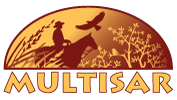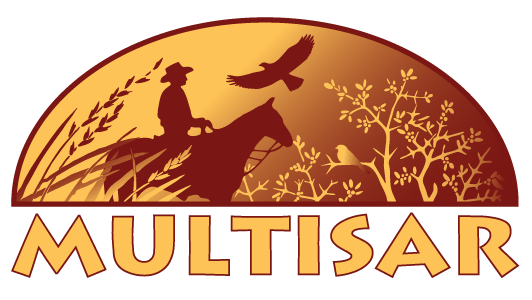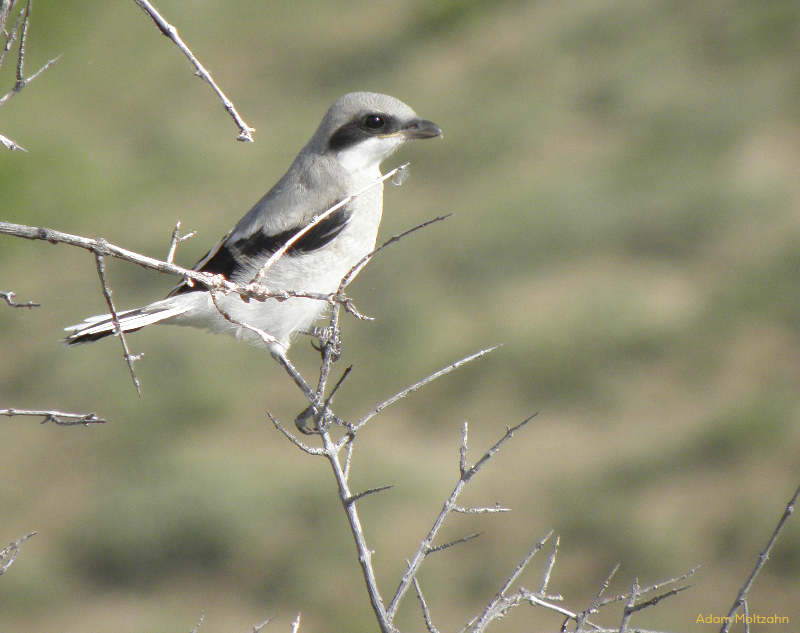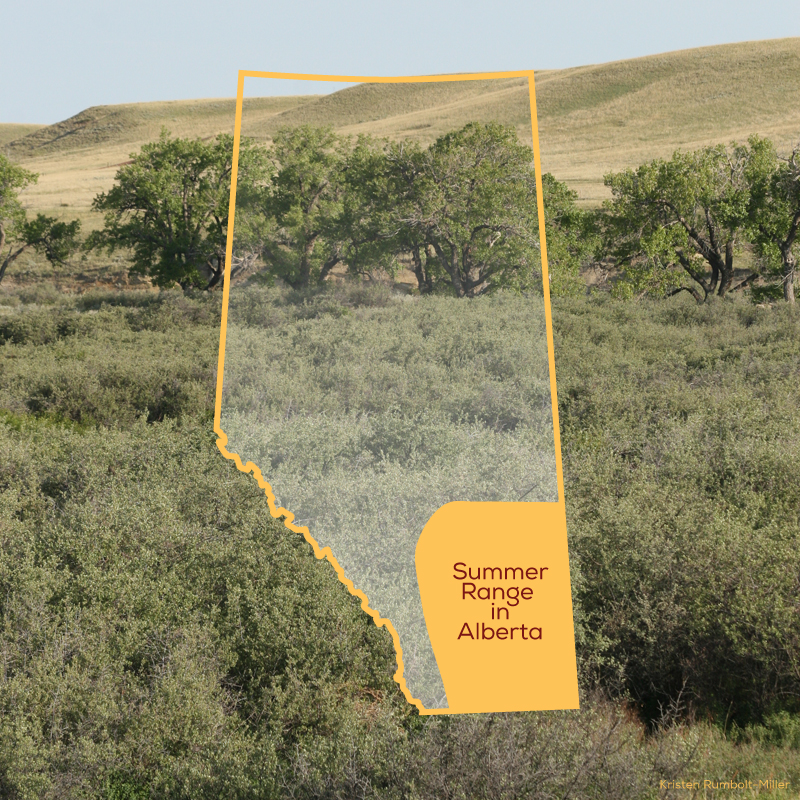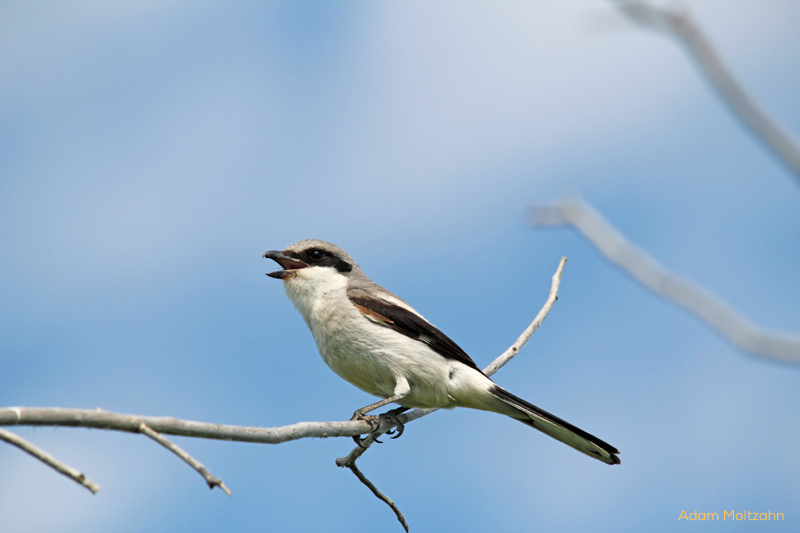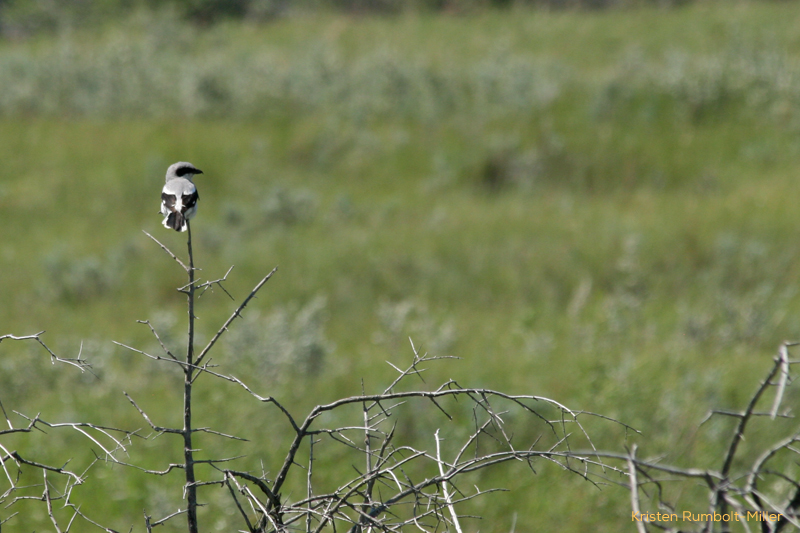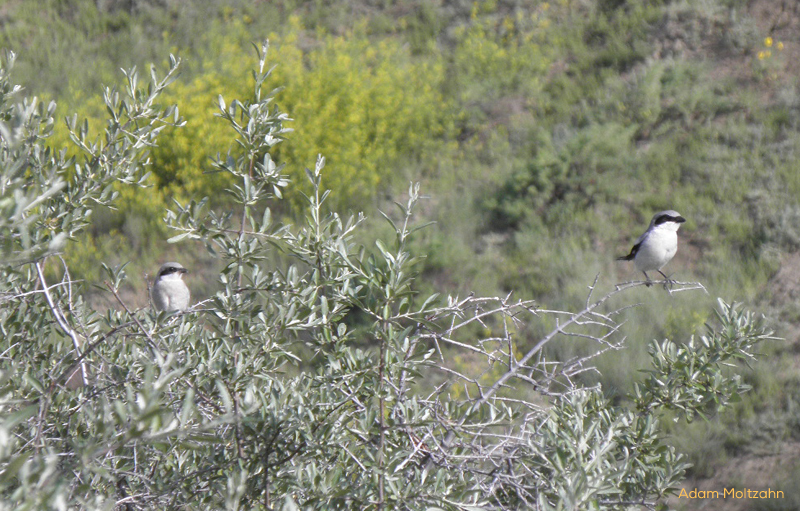Loggerhead Shrike
Lanius ludovicianus
Habitat:
Open grasslands interspersed with occasional shrubs and trees, either naturally occurring or planted, such as shelterbelts and shrubby rights-of-way.
Masked Bird
The Loggerhead Shrike is grey above, white below and a bit smaller than a robin. Key identifying characteristics are a wide black mask on its face and a powerful hooked bill.
Culinary Quirks
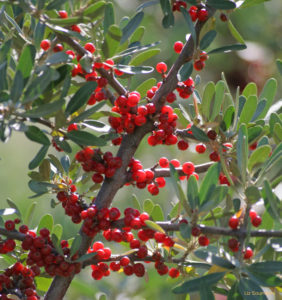
Thorny buffaloberry.
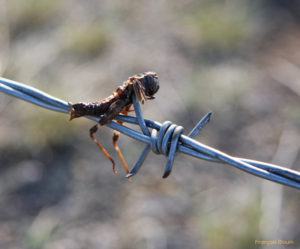
A grasshopper impaled by a loggerhead shrike on a barbed wire fence.
Unlike other songbirds, Loggerhead Shrikes eat small animals. Shrikes do not have strong talons, as raptors do, instead they impale their prey on thorns and barbs. This has earned them the nickname of “butcherbird”. In addition to voles, mice and squirrels, they also eat birds, reptiles, amphibians and insects (primarily grasshoppers).
Shrub Nesters
Loggerhead Shrikes build their nests in shrubs. In Alberta, their preferred nesting shrub is Thorny Buffaloberry (sometimes called Bull Berry), but they also use Willow, Manitoba Maple, Caragana and Sagebrush. Thorny Buffaloberry provides the added advantage of long thorns for impaling their prey!
The Tall and Short of It
Loggerhead Shrikes prefer a variety of grass heights for foraging – some areas of tall grasses to harbor mice and voles and some area of short grasses for hunting insects such as grasshoppers.
Population
Since the 1950s, the range of the Loggerhead Shrike has contracted southwards in Alberta and elsewhere in Canada. The overall population experienced significant declines in most parts of its range in the last half of the 1900s. Recent population surveys show a continued decline, with a 10% decrease in numbers between 2003 and 2013. The current Alberta population is estimated to be approximately 7,500 pairs.
Current Threats
- Conversion of native grasslands to agricultural fields and fragmentation of remaining grasslands results in the loss of suitable breeding habitat.
- Reduction in fires in parkland areas has led to forest encroachment and reduced habitat for shrikes in the northern and western parts of their range in Alberta.
- Cool weather and heavy rain during the nesting season reduces breeding success.
- Pesticide use can affect shrikes both directly (by ingesting it via their prey) and indirectly (by reducing their food supply). Pesticide contamination was likely a significant factor in their decline in the mid-1900s when organochlorides were used.
- Loss and degradation of habitat in wintering areas (southern USA and possibly Mexico).
Species@Risk Quiz
Test your knowledge about Alberta’s grassland species at risk
Loggerhead Shrike
Question 1 |
Loggerhead Shrikes build their nests:
In burrows
| |
On the ground in tall grasses | |
In shrubs surrounded by grasslands |
Question 2 |
The main diet of Loggerhead Shrikes consists of:
Seeds and Buffaloberries
| |
Small mammals, birds and insects | |
Earthworms and beetles |
Question 3 |
Thorny Buffaloberry shrubs are preferred by shrikes because:
The thorns and dense branches help to protect their nests from predators
| |
They can impale their prey on the thorns | |
They can watch for prey from the top of the shrub | |
All of the above |
Question 4 |
Loggerhead Shrikes spend their winters:
In Alberta
| |
In the southern USA and central Mexico | |
On the west coast |
Public
- If you are good at bird identification, consider volunteering for a Breeding Bird Survey route in the grasslands region.
- Support native grassland habitat by choosing grass-fed meat in the grocery store.
- Voice your support for native grassland conservation with your political leaders.
- Educate yourselves and your family about Loggerhead Shrikes and their role in the grassland ecosystem.
Landowners
- Hang on to your native grasslands and natural shrub patches and keep them healthy.
- Maintain shelterbelts and add native shrubs to them. Leave a 2-4 m grassy area around shelterbelts to create shrike foraging habitat near nests. Where possible, reduce the linear nature of shelterbelts by planting shrubs irregularly and in patches.
- Keep some dead trees or dead tree limbs as Loggerhead Shrikes will perch on them to hunt.
- Protect abandoned railroad right-of-ways as they often provide native shrub habitat for shrikes.
- Create variability in your pastures through grazing or other means, as shrikes like a range of grass heights, with taller grasses near their nesting sites.
- Limit grazing of shrubby areas by providing salt and water at alternative locations.
- Limit pesticide use, especially near Loggerhead Shrike nest sites.
- Consider restoring some of your degraded grasslands or marginal croplands to native vegetation typical of your area.
- Talk to your children and neighbours about the privilege of having Loggerhead Shrikes on your land.
What MULTISAR Does
- Participates in Loggerhead Shrike population monitoring.
- Plants shrubs to provide nesting habitat for Loggerhead Shrikes in appropriate areas.
- Cooperates with landowners to restore cropland to native grassland at appropriate locations.
- Provides information about Loggerhead Shrikes and their habitat and recommendations for management practices compatible with their needs and agricultural operations.
